Mezuzah
A mezuzah (Hebrew: מְזוּזָה "doorpost"; plural: מְזוּזוֹת mezuzot) is a piece of parchment called a klaf contained in a decorative case and inscribed with specific Hebrew verses from the Torah (Deuteronomy 6:4–9 and 11:13–21[1]). These verses consist of the Jewish prayer Shema Yisrael, beginning with the phrase: "Hear, O Israel, the Lord (is) our God, the Lord is One". In mainstream Rabbinic Judaism, a mezuzah is affixed to the doorpost of Jewish homes to fulfill the mitzvah (Biblical commandment) to "write the words of God on the gates and doorposts of your house" (Deuteronomy 6:9). Some interpret Jewish law to require a mezuzah in every doorway in the home[2] except bathrooms (which are not a living space), laundry rooms and closets, if they are too small to qualify as rooms.[3] The klaf parchment is prepared by a qualified scribe ("sofer stam") who has undergone training, both in studying the relevant religious laws, and in the more practical parts i.e. carving the quill and practising writing. The verses are written in black indelible ink with a special quill pen made either from a feather or, in what are now rare cases, a reed. The parchment is then rolled up and placed inside the case.
Historic Ashkenazi mezuzah at the entrance to the monumental POLIN Museum of the History of Polish Jews (2014) in Warsaw, containing the Jewish parchment of the mezuzah | |
| Halakhic texts relating to this article | |
|---|---|
| Torah: | Deuteronomy 6:9 and Deuteronomy 11:20 |
| Mishnah: | Menachot 3:7 |
| Babylonian Talmud: | Shabbat 32a, Yoma 11a, Menachot 33a, |
| Mishneh Torah: | Tefillin, Mezuzah, veSefer Torah ch. 5–6 |
| Shulchan Aruch: | Yoreh De'ah 285–291 |
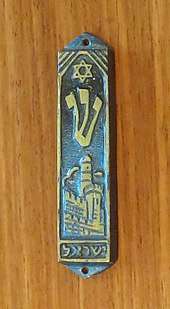
Karaite and Samaritan mezuzah
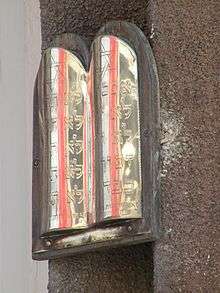
This article deals mainly with the mezuzah as it is used in Rabbinic Judaism. Karaite Judaism and Samaritanism have their own distinct traditions.
In Karaite Judaism the deuteronomic verse "And you shall write them on the doorposts of your houses and your gates" (Deuteronomy 6:9; 11:20) is interpreted to be a metaphor and not as referring to the Rabbanite mezuzah.[4] Thus Karaites do not traditionally use mezuzot, but put up a little plaque in the shape of the two Tables of the Law with the Ten Commandments. In Israel, where they might try not to make other Jews feel uncomfortable, many Karaites make an exception and place a mezuzah on their doorpost as well.[5][6] The Karaite version of the mezuzah is fixed to the doorways of public buildings and sometimes to private buildings, too.[6]
The Samaritans interpret the deuteronomic commandment to mean displaying any select text from the Samaritan version of the five Books of Moses.[7] This can contain a blessing or a particularly holy or uplifting message.[8] In the past they placed a stone plaque inscribed with the Ten Commandments above the house door, some examples dating back to the Byzantine (4th–7th century) and Early Muslim (7th–11th century) periods being now shown in the Israel Museum in Jerusalem.[6][9][10] Nowadays a Samaritan mezuzah is usually made of either marble, a wooden plate, or a sheet of parchment or high quality paper, on which they inscribe select verses from the Samaritan Torah. This they place either above the house door, or inside the house, in the entrance hall or at a prominent place on a large wall.[7][8][11] These mezuzot are found in every Samaritan household as well as in the synagogue.[11] Today some Samaritans would also use a Jewish-style mezuzah case and place inside it a small written Samaritan scroll,[7] i.e. a text from the Samaritan Torah, written in the Samaritan alphabet. The more such mezuzot there are in the house, the better it is considered to be.[8]
Affixing the mezuzah
According to halakha, the mezuzah should be placed on the right side of the door or doorpost, in the upper third of the doorpost (i.e., approximately shoulder height),[12] within approximately 3 inches (8 cm) of the doorway opening. Care should be taken to not tear or damage the parchment or the wording on it, as this will invalidate the mezuzah, which is considered Torah. Generally, halakha requires Jews living in the Diaspora (i.e., outside of the Land of Israel) to affix a mezuzot within 30 days of moving into a rented house or apartment. For a purchased home or apartment in the Diaspora, or a residence in Israel (owned or rented), the mezuzah is affixed immediately upon moving in. The reason for this difference is that there is an assumption that when a Jew lives in Israel, Israel shall remain his/her permanent residence, whereas a home in the diaspora is temporary. Mezuzot are very special objects and must be taken care of carefully and according to Jewish laws and traditions.
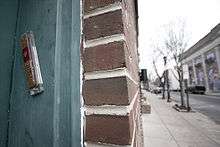
Where the doorway is wide enough, many Ashkenazi Jews tilt the mezuzah so that the top slants toward the room into which the door opens. This is done to accommodate the variant opinions of Rashi and of his grandson, Rabbeinu Tam, as to whether it should be placed vertically (Rashi) or horizontally (Rabbeinu Tam),[13] and also to imply that God and the Torah (which the mezuzah symbolizes) are entering the room. The compromise solution was suggested by Rabbi Jacob ben Asher.[13]
Most Sephardic, Mizrahi and other non-Ashkenazi Jews affix the mezuzah vertically,[14] though Spanish and Portuguese Jews living in countries where the majority of Jews are Ashkenazim usually place it slanting.
The procedure is to hold the mezuzah against the spot upon which it will be affixed, then recite a blessing:
- בָּרוּךְ אַתָּה יי אֱלֹהֵינוּ מֶלֶךְ הָעוֹלָם, אֲשֶׁר קִדְּשַׁנוּ בְּמִצְוֹתָיו וְצִוָּנוּ לִקְבּוֹעַ מְזוּזָה
- Barukh atah Adonai Eloheinu melekh ha‘olam, asher qideshanu bemitzvotav vetzivanu liqboa‘ mezuzah.
- Blessed are You, Lord our God, King of the Universe, Who sanctified us with His mitzvot, and commanded us to affix a mezuzah.
Any Jew can recite the blessing, provided he or she is old enough to understand the significance of the mitzvah. After the blessing, the mezuzah is attached.
Whenever passing through the doorway, many people touch a finger to the mezuzah as a way of showing respect to God in a simpler fashion than saying the prayer. Many people also kiss their finger before touching it to the mezuzah.
When affixing several mezuzot, it is sufficient to recite the blessing once, before affixing the first one.
Checking the parchment
Many observant Jews from all Jewish denominations have a qualified scribe check the mezuzot parchments for defects (such as small tears or faded lettering) at least twice every seven years.[15][16] This job can be done by a sofer (scribe) or by anyone with similar training. A sofer also can make new mezuzot parchments which are in accordance with Jewish Law.
Mezuzah cases
The commandment to affix a mezuzah is widely followed in the Jewish world, even by Jews who are not religiously observant. While the important part of the mezuzah is the klaf, or the parchment, and not the case itself, designing and producing mezuzah cases has been elevated to an art form over the ages. Mezuzah cases are produced from a wide variety of materials, from silver and precious metals, to wood, stone, ceramics, pewter, and even polymer clay. Some dealers of mezuzah cases will provide or offer for sale a copy of the text that has been photocopied onto paper; this is not a kosher (valid) mezuzah,[17] which must be handwritten onto a piece of parchment by a qualified scribe.
Additional inscriptions
It is very customary to write two inscriptions on the back of the parchment:
- the Hebrew word שדי (Shaddai)
- the phrase "כוזו במוכסז כוזו"
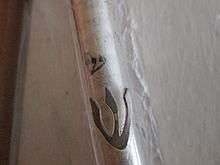
Shaddai, ["Almighty"] one of the biblical names of God, also serves here as an acronym for Shomer Daltot Yisrael, "Guardian of Israel's doors". Many mezuzah cases are also marked with the Hebrew letter ש (Shin), for Shaddai.
"כוזו במוכסז כוזו" is a Caesar cipher—a one-letter shift—of the third, fourth, and fifth words of the Shema, "Adonai, Eloheinu, Adonai", "The Lord, our God, the Lord"; it is written on the back of the case, opposite the corresponding words on the front.[18] This inscription dates from the 11th century and is found among the Hasidei Ashkenaz (medieval German Jewish mystics).
According to the Sephardic custom (minhag), the phrase "כוזו במוכסז כוזו" is prohibited, and only the Hebrew word שדי (Shaddai) is to be written on the back of the mezuzah. This follows the Shulchan Aruch and the writings of the Rambam. The Ashkenazi custom of writing both phrases, however, was supported in the writings of the Remo. (Yoreh De'ah 288:15)
In this regard it is worthwhile to refer to the often cited passage from Rambam's Mishneh Torah which states:
It is a common custom to write [God's name,] Shaddai, on the outside of a mezuzah opposite the empty space left between the two passages. There is no difficulty in this, since [the addition is made] outside. Those, however, who write the names of angels, other sacred names, verses, or forms, on the inside [of a mezuzah] are among those who do not have a portion in the world to come. Not only do these fools nullify the mitzvah, but furthermore, they make from a great mitzvah [which reflects] the unity of the name of the Holy One, blessed be He, the love of Him, and the service of Him, a talisman for their own benefit. They, in their foolish conception, think that this will help them regarding the vanities of the world.[19]
Amuletic usage of mezuzah
The culture-comparative analysis suggests that the objects placed on domestic thresholds often bear the function of an amulet repelling the broadly understood evil.[20] In fact, the early Rabbinic sources explicitly witness the belief in the anti-demonic function of mezuzah. This is the case in e.g. JT Megillah 4:12; BT Bava Metziya 102a; BT Pesahim 113b.[21] The further analysis of the biblical and rabbinic texts (inter alia Deuteronomy 6, 11, Exodus 12, Mekhilta de-rabbi Ishmael 7,12 and BT Menahot 33b, 43b) shows that mezuzah is construed as a device protecting against the divine anger.[22]
The belief in the protective power of mezuzah is prevalent in the modern times as well. In the 1970s after a series of terrorist attacks in Ma'a lot, the representatives of Chabad-Lubavitch started the campaign for the systematic checking of mezuzahs. The general assumption underlying the action was that adhering to the mitzvot would guarantee personal safety.[23]
Finally, according to various pieces of sociological research, approximately three-quarter of adults in Israel believe that the mezuzah literally guards their houses.[24]
Legal battles in the U.S.
The Jewish practice of affixing a mezuzah to the entranceway of a residential unit[25] has been rarely challenged in the United States or Canada,[26] and until recently there was no case law precedent on the subject.
Illinois
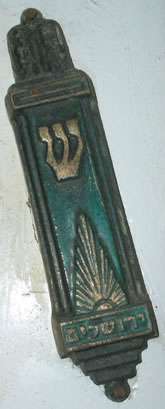
In Chicago in 2001, the condominium association at the 378-unit Shoreline Towers adopted a rule banning "mats, boots, shoes, carts or objects of any sort… outside unit entrance doors",[27] which by board vote in 2004 was interpreted to be absolute.[28] Relying on the association rule, Shoreline Towers management removed the hallway mezuzot of condominium tenants, resulting in letters from Jewish groups which unsuccessfully protested the rule. Complaints by Shoreline Towers tenants were subsequently filed with the Chicago Commission on Human Relations, Illinois Attorney General, and U.S. Department of Housing and Urban Development, alleging housing discrimination on the basis of religion[29] and seeking damages. Meanwhile, a newspaper report indicated that Shoreline Towers was not the sole condominium association in Chicago with such a restriction, although one of them soon agreed to modify its rule.[30]
On reading a news report of the mezuzah dispute at Shoreline Towers, Chicago alderman Burton Natarus, like other Jewish observers of the development,[31] was upset by the ban. He drafted an amendment to the city's municipal code which made it illegal for a renter or owner of an apartment, house, or condo to be prohibited from "placing or affixing a religious sign, symbol or relic on the door, door post or entrance."[32] Although there was opposition to such a move,[33] it became law in Chicago that December.[34] The first such legislation in North America, it included a maximum $500 fine for its violation.
Notwithstanding this legislation, court action continued concerning separate complaints against Shoreline Towers for its rule affecting mezuzot. In 2006, a federal court judge determined that the condominium association's rule did not violate the Federal Fair Housing Act;[35] the district court upheld the opinion on appeal in 2008;[36] in 2009, the U.S. Court of Appeals for the 7th Circuit in Chicago reversed the 2008 decision,[37] and the case proceeded. Meanwhile, during the dispute, records of the Chicago Jewish Star (which had been reporting on the case) were unsuccessfully subpoenaed,[38] and for the first time Illinois’ anti-SLAPP legislation was applied.[39] In 2011, a confidential settlement to the Shoreline Towers disputes was finally achieved.[40]
In 2006, a more narrowly focused amendment to the state's Condominium Property Act was initiated by Illinois Senator Ira Silverstein, the first such state law.[41]
Florida
In 2006, a woman in a 16-story condo building in Fort Lauderdale, Florida, was instructed to remove the mezuzah from her hallway unit and threatened with a fine. After a lengthy legal battle, the condo association was found guilty of discrimination. In 2008, House Bill 995, an amendment to the Florida Condominium Act modeled on the Illinois state legislation, became law.[42]
Texas
In Texas in 2007, a couple living in the Madison Park area of Houston was instructed to "remove the item attached to your door frame" to avoid violating association rules.[43] A legal battle ensued, during which a U.S. District Court judge ruled in 2008 on behalf of the condo association. Subsequently, the couple turned to Texas House of Representatives member Garnet F. Coleman. His bill to protect such religious displays, as introduced in 2009, was not adopted, but in June 2011 a slightly revised version (HB1278) was signed into law by Texas Governor Rick Perry.[44]
Nationwide
A bill designed to prevent mezuzah bans nationwide was proposed in 2008 (H.R. 6932) by U.S. Congressman Jerrold Nadler. It never became law.[45]
References
- Chabad.org
- Maharil. Teshuvos [Responsa].
- Dovid Zaklikowski. "Which Rooms Require a Mezuzah?".
- "Tefillin – Phylacteries". Nehemia's Wall. Nehemia Gordon. 23 June 2014. Retrieved 14 December 2015.
- Nechemia Meyers (10 December 1999). "Israel's 30,000 Karaites follow Bible, not Talmud". j. the Jewish news weekly of Northern California. San Francisco Jewish Community Publications Inc. Retrieved 14 December 2015.
- "The Mezuzah throughout the Ages". Pe'er HasTam. 20 December 2012. Retrieved 14 December 2015.
- "Mezuza (Doorpost)". The Samaritans: The Samaritan Israelite Community in Israel. Samaritan community website. Retrieved 14 December 2015.
- "Tefillin and Mezuzot in Samaritan and Jewish Tradition". Israelite Samaritan Information Institute. Retrieved 14 December 2015.
- "Samaritan mezuzah bearing excerpts from the Ten Commandments, Kefar Bilu, 6th–7th century CE". The Israel Museum Permanent Exhibitions. Israel Museum, Jerusalem. Retrieved 14 December 2015.
- "Samaritan mezuzah bearing an inscription with parts of the Ten Commandments, Mount Gerizim, Samaria, 4th century CE". The aesthetic of the text: the meaning, beauty, and the inspiration of the written word. Dr. Suzan Hazan. Israel Museum, Jerusalem. 2014. Archived from the original on 22 December 2015. Retrieved 14 December 2015.
- "Samaritan Writing and Mezuzah (doorpost)". The Samaritans. Samaritan community website.
- Beit Yosef YD 289; and see Nekudot Hakesef ad loc
- Janowski, Malkie (2016-03-21). "Why Is the Mezuzah Slanted? - Mezuzah". Chabad.org. Retrieved 2017-06-13.
- "Mezuzah - Which Way is UP??".
- Babylonian Talmud, Yoma 11a
- Shulchan Aruch (291:1)
- "Mezuzah Guide". Chabad.org. The Chabad-Lubavitch movement. Retrieved 7 September 2015.
- Alexander Poltorak The Mysterious Name
- Rambam, . (2010). "Hilkhot Tefillin, Mezuzah ve-Sefer Torah 5:4". Mishneh Torah. tr. Eliyahu Touger.CS1 maint: numeric names: authors list (link)
- Frankfurter, David. ""The Interpenetration of Ritual Spaces in Late Antique Religions: An Overview" (2008) in "Archiv für Religionsgeschichte" 10". Retrieved 2016-07-30.
- Jansson, Eva-Maria (1999). The Message of a Mitsvah: The Mezuzah in Rabbinic Literature. Lund. pp. 50–54.
- Kosior, Wojciech. ""It Will Not Let the Destroying [One] Enter". The Mezuzah as an Apotropaic Device according to Biblical and Rabbinic Sources, in "The Polish Journal of the Arts and Culture" 9 (1/2014)". Retrieved 2016-07-30.
- Gordon, M.L. (1977). "Mezuzah: Protective Amulet or Religious Symbol" (PDF). Tradition: A Journal of Orthodox Thought. 16 (4): 7–8.
- Aviezer, Hillel (1997). "Ha-Mezuzah – beyn Mitzvah le-Qamiya'" (PDF). Ma‘aliyot. 19: 217.
- In 1993, 98 percent of Israelis placed a mezuzah on at least the front door to their dwelling, making it the "commandment most widely observed" (Jerusalem Post, December 20, 1993); a 1999 survey in Florida found that in Palm Beach County 89 percent of Jewish residents affix a mezuzah on a doorpost and 87 percent attend a seder (Jewish Telegraphic Agency, December 15, 1999).
- Toronto: League for Human Rights of B’nai Brith Canada, 2000 Annual Audit of Antisemitic Incidents (Ontario Report); Connecticut: Doft v. Washington Mews Condominium Association (2003).
- "Condo revises mezuzah rule," Chicago Jewish Star, September 16, 2005, p. 1.
- Douglas Wertheimer, "Not On Our Doorposts: Chicago condo bans mezuzahs," Chicago Jewish Star, July 15, 2005, p. 2.
- "More mezuzah bans," Chicago Jewish Star, August 5, 2005, p. 2.
- "Ordinance to stop ban on mezuzahs; one condo concedes," Chicago Jewish Star, August 19, 2005, p. 1.
- Howard Dakoff, "Why I Opposed the Mezuzah Ban," Chicago Jewish Star, November 4, 2005, p. 4.
- Municipal Code of Chicago, Unfair Housing Practices (5-8-030/h); Mark Fitzgerald, "Mezuzah muckraking gains legal huzzahs," Editor & Publisher, October 2005, p. 13; "Chicago Law Inspired by ‘Jewish Star’ Articles May Go State-wide," Editor & Publisher, January 26, 2006.
- Editorial, "Give peacemaking a chance," Chicago Sun-Times, September 2, 2005.
- Gary Washburn, "Ethics class eyed for city workers," Chicago Tribune, December 14, 2005.
- Ruth Eglash, "The case of the confiscated mezuzah," Jerusalem Post, June 8, 2006; Editorial, "Judge: Jews Not Welcome," Chicago Jewish Star, September 8, 2006, p. 4.
- Josh Gerstein, "Court: No Federal Right to Mezuzot at Condominiums," New York Sun, July 11–13, 2008, p.4; Dan Slater, "Mezuzah Suit Sparks Ruckus, Impassioned 7th Cir. Dissent," Wall Street Journal Law Blog (July 11, 2008); "Judges rule on Jewish lawsuits. The Hallway mezuzah: Unjustified accommodation or intentional discrimination?" Chicago Jewish Star, July 18, 2008, p. 1.
- "Supreme Court contender [ Diane P. Wood ] mulls mezuzah bias case against condo board," Chicago Sun-Times, May 13, 2009; "Possible Court Pick is Used to Dueling on Bench," Washington Post, May 16, 2009; Courthouse News Service, November 17, 2009; Kenneth E. Kraus, "Court takes a new view of FHA, mezuzah case," Chicago Jewish Star, November 20, 2009, p. 4; J. Schwartz, "Fight Over Jewish Symbol Heads to Trial," New York Times, November 21, 2009; Lynne Bloch, Helen Bloch and Nathan Bloch v. Edward Frischholz and Shoreline Towers Condominium Association, No. 06-3376, 7th Cir. U.S. Court of Appeals, argued May 13, 2009, decided Nov. 13, 2009.
- "Jewish Star objects to subpoena," Chicago Jewish Star, July 27, 2007, p. 1.
- Debbie L. Berman and Wade A. Thomson, "Illinois’ Anti-SLAPP Statute: A Potentially Powerful New Weapon for Media Defendants," Communications Lawyer, vol. 26, March 2009; "Fall-out from mezuzah case impacted by new law," Chicago Jewish Star, April 4, 2008, p. 1; "$36k award in SLAPP-mezuzah case," Chicago Jewish Star, August 7, 2009, p. 1.
- "Families settle mezuzah dispute with Chicago condo," Jewish Telegraphic Agency, July 13, 2011.
- Mark Fitzgerald, "Illinois Gov. Signs Mezuzah Law Inspired by ‘Chicago Jewish Star’," Editor & Publisher, April 12, 2006; Illinois General Assembly, Amendment to the Condominium Property Act SB2165 (April 12, 2006); "Amplification & Update," Chicago Jewish Star, April 28, 2006, p. 3.
- Joe Kollin, "Lauderdale condo bans religious symbol on doorposts," South Florida Sun-Sentinel, February 3, 2007; "Florida condo bans mezuzahs," Chicago Jewish Star, February 9, 2007; "Florida mezuzah ban ends," Chicago Jewish Star, April 20, 2007; Steve Lipman, "Mezuzah Standoff in Ft. Lauderdale," The Jewish Week, February 16, 2007, p. 25; D. Morris, "Richter Wins Fight to Keep Mezuzah," Florida Jewish News, April 13, 2007; "Florida gets a mezuzah bill," Chicago Jewish Star, May 23, 2008, p. 3; Florida House of Representatives, CS/HB 995.
- "Illinois, then Florida – Is Texas next?", Chicago Jewish Star, April 3, 2009, p. 1; Jewish Herald-Voice, April 9, 2009; Jewish Herald-Voice, April 30, 2009.
- "Texas gets a mezuzah law," Chicago Jewish Star, May 27, 2011, p. 1; Kate Shellnutt, "New Texas law defends residents’ religious displays," Houston Chronicle, June 20, 2011; "Perry signs mezuzah bill," Chicago Jewish Star, June 24, 2011, p. 1; Texas House of Representatives, HB 1278 Archived 2012-07-15 at Archive.today.
- New York Sun, September 19–21, 2008, p. 4; "Congress to trump court on mezuzah issue", Chicago Jewish Star, September 26, 2008, p. 1; Chicago Jewish Star, April 3, 2009, p. 13; H.R. 6932: Freedom of Religious Expression in the Home Act of 2008.
Bibliography
- "Documentary on different aspects of mezuzah".
- Alexander Poltorak. A Light unto My Path: A Mezuzah Anthology.
- Dovid Zaklikowski. Mezuzah Handbook.

